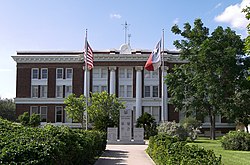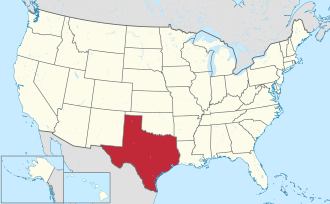History
Willacy County was formed in 1911 from parts of Cameron and Hidalgo Counties, and originally included what is now Kenedy County; it was named for state senator John G. Willacy. Kenedy was split from Willacy in 1921, when the long-settled ranchers of the northern (Kenedy) part of the county sought to separate from the newly arrived farmers of the southern part.
The Bermuda onion was introduced to Willacy County in 1912. It grew well and slowly displaced ranchland in the southern part of the county, becoming the most important crop. For many years, the town of Raymondville held an annual Onion Festival, using the tag line, "The Breath of a Nation". In 1940, the first oil wells were sunk in the county's Willamar Oil Field; today, oil production is a major part of the local economy, although increasingly eclipsed by natural gas. Also in the 1940s, sorghum was introduced to the county, gradually displacing cotton and other crops. Cattle ranching remains a substantial economic activity, as well.
In the early 2010s, wind turbines began to be built in the rural part of the county east of U.S. Highway 77, a number expanded later in 2020. The turbines became an icon to the county's identity, with their being visible from northern Cameron County and eastern Hidalgo County. Power-line infrastructure was also improved in this period.
In recent years, the county has come under scrutiny for police deaths with two in custody deaths in two years. [4] In 2023, the county paid $1,000,000.00 to the family of John Ray Zamora after Zamora died in custody according to attorney Israel G. Perez III. [5] [6] [7] [8]
Demographics
Historical population| Census | Pop. | Note | %± |
|---|
| 1930 | 10,499 | | — |
|---|
| 1940 | 13,230 | | 26.0% |
|---|
| 1950 | 20,920 | | 58.1% |
|---|
| 1960 | 20,084 | | −4.0% |
|---|
| 1970 | 15,570 | | −22.5% |
|---|
| 1980 | 17,495 | | 12.4% |
|---|
| 1990 | 17,705 | | 1.2% |
|---|
| 2000 | 20,082 | | 13.4% |
|---|
| 2010 | 22,134 | | 10.2% |
|---|
| 2020 | 20,164 | | −8.9% |
|---|
|
Willacy County, Texas – Racial and ethnic composition
Note: the US Census treats Hispanic/Latino as an ethnic category. This table excludes Latinos from the racial categories and assigns them to a separate category. Hispanics/Latinos may be of any race.| Race / Ethnicity (NH = Non-Hispanic) | Pop 2000 [14] | Pop 2010 [12] | Pop 2020 [13] | % 2000 | % 2010 | % 2020 |
|---|
| White alone (NH) | 2,350 | 2,235 | 1,805 | 11.70% | 10.10% | 8.95% |
| Black or African American alone (NH) | 401 | 389 | 445 | 2.00% | 1.76% | 2.21% |
| Native American or Alaska Native alone (NH) | 24 | 22 | 47 | 0.12% | 0.10% | 0.23% |
| Asian alone (NH) | 21 | 134 | 160 | 0.10% | 0.61% | 0.79% |
| Pacific Islander alone (NH) | 0 | 1 | 2 | 0.00% | 0.00% | 0.01% |
| Other Race alone (NH) | 14 | 9 | 34 | 0.07% | 0.04% | 0.17% |
| Mixed Race or Multiracial (NH) | 63 | 47 | 60 | 0.31% | 0.21% | 0.30% |
| Hispanic or Latino (any race) | 17,209 | 19,297 | 17,611 | 85.69% | 87.18% | 87.34% |
| Total | 20,082 | 22,134 | 20,164 | 100.00% | 100.00% | 100.00% |
As of the 2010 United States census, 22,134 people, 5,764 households, and 4,607 families were living in the county. Of all households, 46.0% had children under 18 living with them, 54.5% were married couples living together, 19.3% had a female householder with no husband present, 6.1% had a male householder no wife, and 20.1% were not families. About 32.9% of all households contained an individual who was 65 years of age or older. The average household size was 3.28, and the average family size was 3.73.
Of the population, 85.8% of residents were White (10.1% non-Hispanic white), 2.1% Black or African American, 0.6% Asian, 0.3% Native American, 9.3% of some other race and 1.8% of two or more races. 87.2% of residents were Hispanic or Latino (of any race).
In the county, the age distribution was 26.8% under 18, 12.3% from 18 to 24, 27.8% from 25 to 44, 21.4% from 45 to 64, and 11.7% who were 65 or older. The median age was 32 years.
The median income for a household in the county was $22,881, and for a family was $25,399. The per capita income for the county was $10,800. 39.4% of families and 43.4% of the population were below the poverty line, including 50.5% of those under age 18 and 38.3% of those age 65 or over. The county's per-capita income makes it among the poorest counties in the United States. [15]
This page is based on this
Wikipedia article Text is available under the
CC BY-SA 4.0 license; additional terms may apply.
Images, videos and audio are available under their respective licenses.



